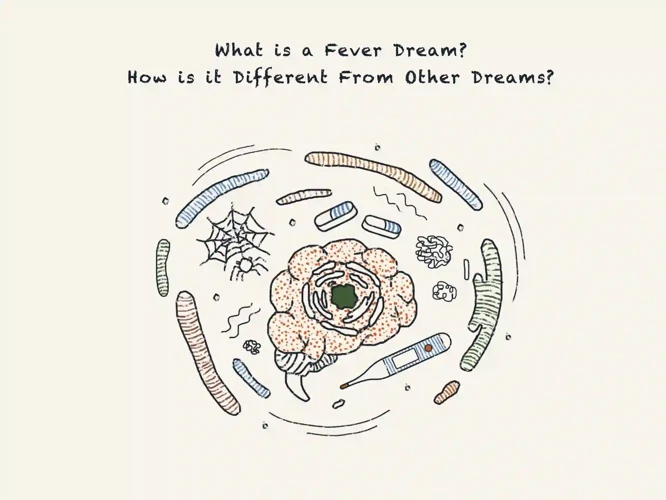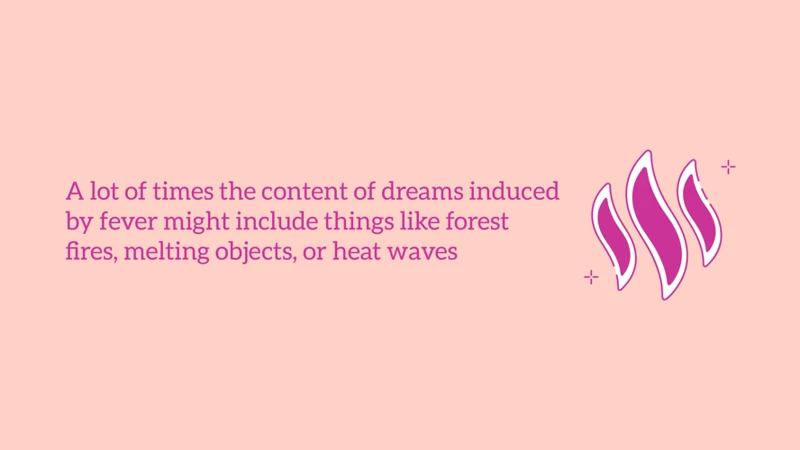Have you ever woken up from a night of sleep feeling disoriented and enthralled by the vividness of your dreams? If so, you may have experienced what is commonly known as a “fever dream.” Though the term itself may sound mysterious, fever dreams are actually a natural phenomenon that occur during periods of elevated body temperature. In this article, we will explore the meaning of a fever dream, the possible causes behind them, and how they provide a window into our subconscious minds. So, buckle up and get ready to delve into the intriguing world of fever dreams!
What is a Fever Dream?

A fever dream is a type of vivid and surreal dream that occurs when a person has an elevated body temperature, usually due to an illness or infection. These dreams are characterized by intense and often bizarre imagery, distorted perception of reality, and a heightened sense of emotions. They can be unsettling and confusing, blurring the line between the dream world and waking reality. Fever dreams are often accompanied by physical symptoms such as sweating, rapid heartbeat, and shivering. While they can be unsettling, they are generally harmless and tend to subside once the underlying cause of the fever is treated. So, what exactly triggers these strange and captivating dreams? Let’s explore the possible causes in the next section.
Causes of Fever Dreams

There are several factors that can contribute to the occurrence of fever dreams. Here are the main causes to consider:
1. High Body Temperature: When our body temperature rises due to fever, it can affect the brain’s normal functioning, leading to vivid and unusual dreams.
2. Medications: Certain medications, such as antibiotics, antimalarials, and antipsychotics, have been known to cause side effects like vivid dreams or nightmares.
3. Illnesses: Various illnesses and infections, including flu, malaria, and COVID-19, can trigger fever dreams as a result of the body’s immune response and the release of inflammatory substances.
4. Dehydration: When our body is dehydrated, it can disrupt normal sleep patterns and increase the likelihood of experiencing intense dreams, including fever dreams.
It’s essential to keep in mind that while fever dreams can be unsettling, they are generally short-lived and harmless. Understanding the underlying causes can help manage them effectively. Let’s now delve into how these dreams offer insights into our subconscious minds.
1. High Body Temperature
High body temperature is one of the primary causes of fever dreams. When our body temperature rises, it can disrupt the normal sleep cycle, leading to disturbances in our dreams. The brain becomes more active during fever, and this heightened neural activity can result in vivid and unusual dream experiences. Additionally, the body’s attempt to regulate its temperature can lead to sweating, discomfort, and restlessness, all of which can contribute to the intensity and strangeness of fever dreams. These dreams may involve surreal scenarios, fantastical creatures, or even exaggerated versions of real-life events. So, when your body temperature rises, be prepared for a wild and unpredictable journey into the realm of fever dreams.
2. Medications
Medications can sometimes be a culprit behind the occurrence of fever dreams. Certain drugs, such as antihistamines, antidepressants, and sleep aids, can disrupt the normal sleep cycle and lead to vivid and unusual dreams. Additionally, fever-reducing medications, like ibuprofen, can also affect the dream state. These medications may alter brain chemistry and interfere with the REM (rapid eye movement) sleep phase, where most dreaming occurs. As a result, the dreams experienced during this disrupted sleep can be more intense and surreal. It’s important to note that not everyone who takes medications will experience fever dreams, as individual reactions can vary. If you suspect that a medication may be contributing to your fever dreams, it’s advisable to consult with a healthcare professional.
3. Illnesses
Illnesses are a common cause of fever dreams, as our bodies react to infections and other medical conditions. Some illnesses that can lead to fever dreams include:
1. Influenza: The flu virus can cause high fever, muscle aches, and fatigue, which can all contribute to the occurrence of fever dreams.
2. Malaria: This mosquito-borne illness often causes fever and chills, which can trigger intense and vivid dreams.
3. Delirium: Serious illnesses such as pneumonia or sepsis can cause delirium, a state of confusion and disorientation, which may manifest as fever dreams.
4. COVID-19: The coronavirus, known to cause respiratory illness, can also lead to feverish symptoms and subsequent fever dreams in some individuals.
It’s important to note that fever dreams are a natural response to the body’s elevated temperature and should subside once the underlying illness is treated. If you’re experiencing prolonged or severe fever dreams, it’s always best to consult a healthcare professional for further evaluation and guidance.
4. Dehydration
Dehydration, the lack of sufficient water in the body, is another potential cause of fever dreams. When the body is dehydrated, it can disrupt normal sleep patterns. This disruption can lead to vivid and intense dreams, including fever dreams. Dehydration can also result in physical discomfort and irritability, which may further influence the content of these dreams. It is important to stay hydrated throughout the day, especially in hot weather or during periods of intense physical activity, to help prevent dehydration-related fever dreams. So, remember to drink plenty of water to keep both your body and your dreams hydrated!
How Do Fever Dreams Reflect Our Subconscious?

Fever dreams have long been a subject of fascination due to their ability to offer a glimpse into the inner workings of our subconscious minds. They can reveal hidden fears, desires, and unresolved emotions that are deeply buried in our psyche. One way fever dreams reflect our subconscious is through symbolism and metaphors. In these dreams, ordinary objects or events may take on profound meanings that relate to our inner thoughts and experiences. Additionally, fever dreams provide an outlet for emotional expression. They can magnify our feelings of anxiety, stress, or joy, allowing us to process and release pent-up emotions. Lastly, fever dreams are highly personal experiences. They are often influenced by individual memories, traumas, and life experiences, acting as a unique window into our personal history and identity. By decoding the messages hidden within fever dreams, we can gain valuable insights into our subconscious mind and use them as tools for self-reflection and understanding.
Interpreting Fever Dreams

Interpreting fever dreams can be an intriguing endeavor, as they offer a unique glimpse into our subconscious minds. While the specific meanings of fever dreams vary from person to person, there are some common approaches to interpreting them. One approach is to analyze the symbolism and metaphors present in the dream. These symbols can provide insights into our fears, desires, and unresolved emotions. Another way to interpret fever dreams is by exploring the emotional expressions embedded within them. The heightened emotions experienced during these dreams can reflect our subconscious thoughts and feelings. Additionally, considering our personal experiences and memories can help shed light on the underlying meaning of fever dreams. By examining the content of the dream in relation to our life experiences, we can gain a better understanding of the messages our subconscious mind is trying to communicate to us. Keep in mind that dream interpretation is subjective, and it is important to consider the context and individual circumstances when analyzing fever dreams.
1. Symbolism and Metaphors
Symbolism and metaphors play a prominent role in interpreting fever dreams. These dreams often contain elements that represent deeper meanings and emotions. The surreal and chaotic nature of fever dreams allows our subconscious mind to express itself symbolically. Objects, people, or situations in the dream may hold hidden significance and reflect our innermost thoughts, fears, or desires. Deciphering these symbols can provide insight into our subconscious mind, allowing us to explore unresolved issues or gain a new perspective on our waking life. It is important to approach the interpretation of fever dreams with an open mind and consider the personal context and experiences of the dreamer.
2. Emotional Expression
Emotional expression is a key aspect of interpreting fever dreams. These dreams often serve as a platform for our subconscious to process and express emotions that may be difficult to confront in our waking lives. As the mind tries to make sense of the heightened emotional state created by a fever, it may manifest in the form of intense and symbolic scenarios in dreams. For example, a person experiencing feelings of anxiety or fear may have fever dreams filled with suspense, danger, or monsters. On the other hand, someone who is feeling overwhelmed with joy or excitement may have fever dreams filled with vibrant colors, euphoric scenes, or thrilling adventures. These dreams can provide valuable insights into our emotional well-being, allowing us to explore and acknowledge our deepest emotions in a safe and symbolic way.
3. Personal Experience
Personal experience plays a significant role in the interpretation of fever dreams. Each individual has a unique set of memories, emotions, and experiences that shape their dreams. What may appear as a random assortment of images and events in a fever dream can hold personal significance and meaning to the dreamer. Symbols, people, or situations that are familiar to the individual may appear in their fever dreams, reflecting their personal history and subconscious mind. For example, a long-lost loved one or a childhood home may manifest in a fever dream, triggering emotions and memories associated with that particular person or place. The intensity of these personal connections can make fever dreams particularly impactful and memorable for the dreamer.
Tips to Manage Fever Dreams
When it comes to managing fever dreams, there are several strategies you can try to help ease the intensity and improve your sleep. Firstly, prioritize rest and hydration to support your body’s healing process and reduce the frequency of fever dreams. Make sure to drink plenty of fluids and get enough sleep to promote overall well-being. Secondly, temperature control plays a crucial role. Keep your bedroom cool and comfortable by adjusting the thermostat or using a fan. This can help regulate your body temperature and minimize the occurrence of fever dreams. Thirdly, if you are taking medications that contribute to fever dreams, consult with your healthcare provider about adjusting the timing or dosage to potentially minimize their impact. Lastly, creating a calming environment before bed can help reduce stress and anxiety, which may intensify fever dreams. Consider practicing relaxation techniques such as deep breathing, meditation, or listening to soothing music. By implementing these tips, you can take proactive steps to manage fever dreams and promote more restful sleep.
1. Rest and Hydration
Rest and hydration play a crucial role in managing and reducing the occurrence of fever dreams. When your body is well-rested and properly hydrated, it can help regulate your body temperature more effectively. Ensuring that you get adequate sleep and maintain proper hydration levels throughout the day can contribute to a more stable body temperature, reducing the likelihood of experiencing fever dreams. Rest allows your body to recover and heal, while hydration helps maintain a balanced internal environment. So, prioritize quality sleep and drink plenty of fluids to keep yourself well-rested and hydrated, potentially minimizing the occurrence of fever dreams.
2. Temperature Control
Maintaining temperature control is key when it comes to managing fever dreams. Keeping your bedroom at a cool and comfortable temperature can help prevent excessive sweating and discomfort during sleep. Use lightweight and breathable bedding materials, and consider using a fan or air conditioner to create a cooler environment. Additionally, dress in light and loose-fitting sleepwear to promote airflow and minimize overheating. By regulating your body temperature, you can reduce the intensity and frequency of fever dreams, allowing for a more restful sleep experience.
3. Medication Timing
When it comes to managing fever dreams, paying attention to medication timing can make a significant difference. Some medications, particularly those that affect the central nervous system, can disrupt sleep patterns and contribute to the occurrence of intense dreams. Taking certain medications right before bed can increase the likelihood of experiencing fever dreams. To minimize the impact of medications on your dream experiences, consider taking them earlier in the day, spacing out doses to avoid taking them too close to bedtime, or consulting with a healthcare professional for alternative options. Additionally, keeping track of the side effects of medications and discussing any concerns with your doctor can be beneficial in managing fever dreams effectively. Remember, a proper understanding of medication timing can help alleviate the intensity of these captivating dreams.
4. Creating a Calm Environment
Creating a calm environment is essential when managing fever dreams. A peaceful and soothing atmosphere can help promote relaxation and reduce anxiety, making it easier to fall asleep and have more restful dreams. To create a calm environment, consider dimming the lights, playing soft and soothing music, using aromatherapy with calming scents like lavender, and keeping the room at a comfortable temperature. It’s also helpful to establish a bedtime routine that includes activities such as reading a book, practicing deep breathing or meditation, or taking a warm bath before sleep. By prioritizing a calm environment, you can encourage a sense of tranquility and improve the quality of your sleep, reducing the intensity and frequency of fever dreams.
Conclusion
In conclusion, fever dreams are fascinating and strange phenomena that occur when our body temperature rises. They can be triggered by factors such as high body temperature, medications, illnesses, and dehydration. Fever dreams provide a glimpse into our subconscious mind, reflecting our emotions, personal experiences, and using symbolism and metaphors to convey hidden messages. While the experience of fever dreams may be unsettling, there are ways to manage them, such as getting ample rest and hydration, controlling the temperature in our environment, and timing medications appropriately. By understanding the meaning of fever dreams and how to interpret them, we can gain insights into our inner thoughts and emotions. So, the next time you find yourself in the midst of a fever dream, embrace the surreal experience and explore the depths of your subconscious mind.
Frequently Asked Questions
1. Can fever dreams be dangerous?
No, fever dreams are generally not considered dangerous. They are just a result of the elevated body temperature and tend to subside once the underlying cause of the fever is addressed.
2. Are fever dreams only experienced during fevers?
Yes, fever dreams are primarily experienced during periods of elevated body temperature. They are often associated with illnesses or infections that cause a fever.
3. Are fever dreams the same as nightmares?
No, fever dreams and nightmares are not the same. While both can be intense and vivid, fever dreams specifically occur during episodes of fever, whereas nightmares can occur at any time and are typically associated with feelings of fear or distress.
4. Can certain medications cause fever dreams?
Yes, some medications, particularly those that affect the central nervous system or have sedative properties, can potentially trigger vivid dreams or nightmares, including fever dreams.
5. Can dehydration lead to fever dreams?
Yes, dehydration can contribute to the occurrence of fever dreams. A lack of proper hydration can affect brain function and lead to abnormal dream patterns.
6. Can fever dreams reveal hidden fears or desires?
While it is possible, fever dreams are not necessarily indicative of hidden fears or desires. They are more closely related to the physiological effects of a fever rather than the content of one’s subconscious thoughts or desires.
7. Can fever dreams be interpreted like regular dreams?
Yes, fever dreams can be interpreted like regular dreams. They often contain symbolism and metaphors that can provide insight into one’s emotions, experiences, or subconscious mind.
8. Are there any specific techniques to remember fever dreams?
There are no specific techniques to remember fever dreams, but keeping a dream journal by your bedside and jotting down any details upon waking can help improve dream recall, including those experienced during a fever.
9. Can fever dreams be influenced by external factors?
Yes, external factors such as the sleep environment, noise, or personal experiences can influence the content and intensity of fever dreams, just as they can with regular dreams.
10. Should I be concerned if I frequently experience vivid fever dreams?
If you frequently experience vivid fever dreams that significantly disrupt your sleep or cause distress, it may be worth discussing with a healthcare professional to rule out any underlying issues or explore potential management strategies.


